Customs and Traditions
Customs and Traditions The customs and traditions of Bangladesh are varied and fascinating. Some are rooted in its little-known prehistory and some have been carried through the ages by hundreds of aboriginal tribes who came to the subcontinent from many parts of the old world. Many of these tribes with their pristine cultural traits still thrive in the plains, forests and hills of Bangladesh. Their ancestors were either, the Negritos or, Proto-Australoids, Proto-Mongoloids or, Caucasoids. They were followed by the Aryans from West Asia. The ethnic composition of Bangladesh has largely been influenced by the fertility of a delta, which is washed by scores of large and small rivers, a hospitable climate, and fabled wealth that has attracted settlers, conquerors, traders and fortune-seekers. It was indeed a crucible of various ethnic groups, who blended together to form a mosaic of mixed races with a dominant non-Aryan strain. Fertile lands and vast waterbodies have made agriculture and fishing the dominant occupations of the people. rice, vegetable and fish have therefore become their main foods.
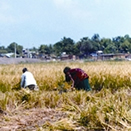
Many of the customs have grown round the agricultural practices. Navanna is the age-old festival of new harvest and takes place in the Bengali month of Agrahayana (November-December), proverbially known as the month of plenty. The advent of the winter brings welcome relief from the sweltering heat and humidity of the long summer and flooding of the plains. As men bring golden paddy home for thrashing, women get busy making pitha with new rice to be soaked in date-palm juice and milk. As the waterbodies start shrinking, fish in plenty get caught in the nets of the fishermen to the great delight of every home. This is also the start of the season of such popular country sports as kabadi and bull-race. The season is also preferred for playing cricket, badminton and several other outdoor games.
Pahela Baishakh (Bangla Navabarsha), Bengali new year's day which falls in the middle of April, is celebrated throughout Bangladesh as a traditional festival. The day starts with the people taking a breakfast of pantabhat or soaked rice with fried fish or vegetable curry or cheera, gud and yoghurt.
Men, women, and children then wear their best and rush to fairs that are usually held under the cool shade of banyan trees or at riverfronts. The fairs or melas bring commodities of every sort, unending varieties of food and sweets and arrays of clay and plastic dolls for children. Women never fail to buy a set of glass or plastic bangles. A great variety of entertainment, including merry-go-rounds, swings, horse-riding, try-your-luck games, theatrical or opera performances and puppet shows are arranged. Businessmen of all communities observe the day with a great degree of solemnity as they open halkhatas or new account books. Hindus daub the books with sindur for good luck. Pahela Baishakh is also popular in urban areas. In dhaka, the day is celebrated in a big way with musical soirees, colourful processions and melas. Some melas last for a week. Quite often the merriment of the day ends when a kalboishakhi or nor'wester gale coming from the northwestern sky raises a dust-storm followed by torrential rain and thunderstorm. At times it causes damage to life and property but it also cools down the sweltering heat of the summer.
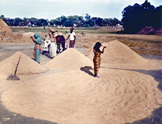
Society in Bangladesh is still characterised by joint families and respect for women and elders and love and care for children. Old parents and elderly dependants are taken care of by the families of their sons or daughters or relatives as their good wishes and prayers are deeply valued as propitious for receiving God's kindness. Muslims greet their elders in the Islamic way with assalamu alaikum with the right hand raised to touch the forehead and Hindus with namashkar accompanied by folded palms.
The birth of a child is celebrated with distribution of sweets among relatives and friends. The naming ceremony is observed with a feast and invitees bring gifts for the child. Khatna or mussalmani (circumcision), common among Muslims, is also an occasion for celebration and feasting. A new-born is always given a black spot on its forehead as protection against someone's evil eye. Often a tabiz, a tiny copper case containing a religious verse, or a holy man's words of blessings, is tied round the neck of the child for its protection. These may be superstitions coming down from old tribal cultures but people in general still cling to their beliefs in many such superstitions and go to religious and non-religious soothsayers and ascetic persons claiming, most often hypocritically, supernatural powers to exorcise evil or cure an illness by uttering charms and incantations. An empty pitcher, a broomstick, an odd number of salik birds, a crow cawing, a black cat crossing the way, or a dead body appearing in sight would be deemed inauspicious for a journey.
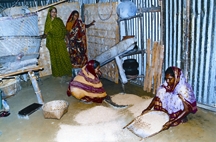
In spite of overwhelming religious influences and rapid expansion of education and modern amenities, people in rural and tribal communities still retain an unconscious faith in animism. A sprawling banyan tree is forever a matter of awe and people will always avoid going under it at night as there might be jins, ghosts or other evils spirits lying in wait in the darkness of its foliages for a victim. Belief in jins and spirits is quite widespread. Shitala and Ola are spirit deities of smallpox (now eradicated) and cholera and, when there is an outbreak, they must be appeased by special prayers at temples and mosques and offerings of sacrifices. In case of snakebite, people may rush to a local ojha who is believed to have the power to call back the snake to suck the poison out of the victim's body. For a remedy from rheumatic pain, people in villages still go to bedenis (bedey women) living on boats so that poisonous blood can be extracted from the patient's body.
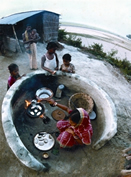
Beggars are widely patronised as they are often regarded as saints in disguise. Beggars coming to the door of a house of any community are seldom refused alms. People in distress or in sickness usually go to a place of worship to pray or to a beggar or a holy man to give alms for blessing. They do the same when a child is born and at every point of his/her crossing an important stage in life such as an examination, a competitive test, journey abroad for study, or employment, or getting married. The birth of a male child is regarded as a matter of good fortune as he will be an earning member of the family; a female child is often treated as a liability. People frequently make manat or a vow to make a particular sacrifice, or offer a gift to a deity or at a holy place on fulfilment of a prayer. Manats at times mean offering feasts to poor people, orphans and relatives. At times of extreme drought affecting farming, Muslims offer special prayers at about midday in a big congregation to ask Allah for rain, not always without results. Muslims and Christians bury their dead, while Hindus cremate them. Muslims observe a qulkhwani on the fourth day and a chehlum on the 40th day of the death of a relation while Hindus hold a shraddha with the sons of the deceased shaving off their heads in mourning. In all cases offering sweets and feasts is a regular custom.
Most communities in rural Bangladesh prefer to arrange marriages during cooler and drier months as there is abundance of food and communication is easier for the bridal parties to travel. In urban areas, weddings take place throughout the year, except during the holy month of ramadan (for Muslims), and during the period of abstinence after the death of a near relative in the family of either party.
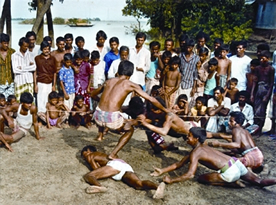
Most marriages are still arranged by parents or close relatives, often with the help of a professional ghatak or matchmaker who maintains an up-to-date list of prospective grooms and brides with complete accounts of their family trees and histories. He belongs to a breed that possesses the ability to mix facts with fiction in the right chemical proportion to make the impossible happen - all for a very modest reward. Ghataks unite hearts but most people believe they do so in fulfilment of the union predetermined in heaven. Essential features of these marriages are feasts arranged by both parties for a large number of guests, who bring gifts for the bride and the groom. Depending on the resources of the parents of the groom and the bride, guests may number from 500 to 50,000.
The menu at the Muslim feast is always a reminder of the Mughal emperor's food - beef kebab, chicken roast, mutton rezala, mutton/chicken biryani, burhani of spiced yoghurt, salad and zarda/payesh as sweet. Hindu feasts consist of plain rice, a vegetable dish, a fish curry, a curry of the meat of an uncastraded goat and sweetened yoghurt. In chittagong, wedding feasts may go on for days.
The wedding ceremony is preceded by several other rituals including panchini to signify conclusion of negotiations and halud at both ends to put turmeric paste on the bodies of the groom and the bride, apparently for their skins to glow brighter. Gifts are invariably exchanged on these occasions. Payment of dowry or bride money is common to both Hindu and Muslim communities. High-caste Hindu grooms usually receive dowries. Dearth of good grooms and brides often determine which side should pay and which side should receive dowry and how much. A Hindu groom invariably puts sindur or scarlet vermilion powder at the sithi or parting of the hair of the bride according to a custom believed to have come down from ancient tribes. He also gives her a pair of shankha (conch-shell bangles), which she is to wear all her life. All married Hindu women use vermilion at their sithi as a daily ritual until they die or are widowed.
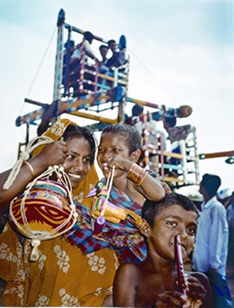
All Muslim and Hindu marriages take place at the bride's house in the presence of elders and relatives of both parties. A government appointed marriage registrar conducts the ceremonies of a Muslim marriage, recording in writing all conditions of the contract after obtaining consent of the bride through a vakil and two witnesses. The contract usually allows either party to divorce under certain conditions. For a Hindu marriage, first the birthdays of the couple have to be scrutinised in relation to the positions of their stars to ensure that their union would be compatible, and then the time and date for the wedding are fixed after another scrutiny of the positions of the stars. Next, a qualified purohit conducts the marriage by reciting mantras from the scriptures as the bride is given away to the groom by her father. The couple, with their dresses knotted together, go round a fire seven times. It is said the couple is now tied for life by satpak (seven rounds of knots) with agni sakkshhi or fire as witness so that nothing but death can separate them. Christian marriages take place at churches. Catholics marry for life and cannot obtain a divorce; Protestants can divorce each other. Wedding ceremonies of all communities lead to the phool shajya night when the new couple enjoy conjugal love on a bed profusely decorated with fragrant flowers and colourful draperies. This is regarded as the finest night for a new couple, affectionately designated as the king and the queen, who set off together to a life of love, understanding, and happiness as heavenly blessings and prayers of the well-wishers pour down on them.
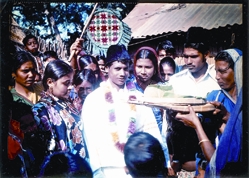
A very significant festival for Muslims, who constitute about 85 percent of the country's population, is eid-ul fitr. It comes at the end of the fasting month of Ramadan and last for three days designated as national holidays. Festivities start with donation of fitra, the value in money of a certain amount rice or wheat per head per family, given to the poor. Then all men and boys, attired in new clothes like everyone else in the family, attend mid-morning Eid prayers at idgahs or mosques. Prayers over, they embrace each other wishing eid mubarak irrespective of their positions in society in the spirit of Islamic brotherhood. They come back to savour delicious sweet dishes prepared at home. More elaborate dishes are served at lunch and relatives and friends are very welcome to join in. The afternoon is for visiting close relatives and friends attired in new clothes. The occasion is of great national importance and radio and television put out special programmes and newspapers and periodicals bring out supplements to mark it. Official buildings are illuminated and the entire country wears a festive look.
Eid-ul Azha, another important Muslim festival falls on the 10th of the arabic month of Zilhaj, synchronising with hajj in Mecca. Hajj is compulsory for those Muslims who are able physically and financially to travel to Mecca. Over two million Muslims from all over the world, including about twenty thousand from Bangladesh, perform Hajj every year. Here in the country people go to idgahs and mosques for mid-morning prayers and come back to sacrifice cows and goats, mandatorily distributing a major portion of the meat among the poor and poor relations.
Ramadan itself is a month of great solemnity with Muslim adults observing fast from pre-dawn to sunset. The fast is ended with iftar of sharbat, some fried items, and fruits. It is a month of austerity and teaches people to be kind to the poor, exercise self-restraint and inculcate the spirit of sacrifice. The rich are required to pay zakat, a tax designed for poverty alleviation in the society.
Shab-e-qadr is a night of special blessings and is observed in Bangladesh at the close of the 26th Ramadan with a whole night of prayers for Allah's blessings. shab-e-barat is a night of fortune that falls on the 14th of month of Shaban of the Arabic calendar. Most Muslims spend the night in prayers for Allah's mercy. Housewives prepare sweet dishes and flat bread for distribution among the poor. Eid-e-Miladunnabi is observed on the 12th of Rabiul Awwal, the day Prophet Muhammad was born in 570 AD in Mecca to become islam's last prophet. It is a public holiday. Radio and TV broadcast special programmes to highlight his place in Islam as he is believed to have been Allah's dearest being in the entire universe.
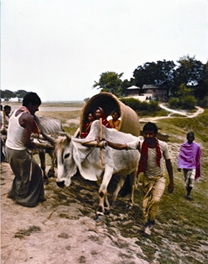
Durga Puja is the most important among the religious festivals of Hindus. For ten days beginning with the first appearance of the moon in the Bengali month of Aswin (September), devotees worship the image of goddess Durga made in clay with great care by potters in different places. Youths dance before the image to the sound of drums and cymbals and visitors from all communities are given sweets. On the 10th day the image is immersed in a river or pond as devotees weep in distress at the demise of their mother goddess. As in the Eid of the Muslims, members of the Hindu families wear new clothes and dainty dishes are prepared for them as well as for guests. Radio and TV broadcast special programmes on the occasion. A very special custom of the Hindus is taking an annual dip in the ganges or in any of its tributaries for washing down their sins. One such place, langalband in narayanganj district, draws hundreds of thousands of devotees who take bath here in the waters of the old brahmaputra.
In tune with the rest of the world, Christians of Bangladesh celebrate christmas on 25 December. They decorate their houses tastefully and a Christmas tree is lit with tiny multi-colour bulbs so that they can glitter like stars. The families enjoy the traditional Christmas dinner in the company of friends and relatives. The angel Santa Claus goes round homes carrying a fat bag to give away surprise gifts to children. Newspapers publish special features and radio and TV broadcast special programmes on the occasion.
Buddhists also have a number of religious festivals centering round the life and works of Gautam Buddha. buddha purnima, falling on the full-moon day of Baishakh, is their main festival. This day is associated with three important events of Buddha's life - his birth in 623 BC, his attainment of supreme wisdom in 588 BC to become known in the world as Buddha, and the complete extinction of his self or death at the age of 80 in a sal forest on the bank of Hirannabati in 543 BC. On the day of Buddha Purnima, Buddhists worship Lord Buddha and arrange panchasheel, ashtasheel, sutrapath, sutrasraban, collective prayers, and various other religious ceremonies. Apart from the religious rites, a variety of social and cultural events are also organised. Festivities are organised for children. Many Bouddha Viharas organise three-day celebrations. Many people visit the famous ruins of the viharas of mahasthan, paharpur and mainamati, which are relics of the finest specimens of Buddhist civilisation and culture. Radio and TV broadcast special programmes and newspapers bring out special issues or supplements. On the occasion, various viharas and organisations publish souvenirs, magazines and memorial books. Fairs are held on the day at different villages and viharas, including the Bodhidroom Mela at village Baidyapara in Chittagong. Tribal communities living in forests, tea gardens, plains, and the hill tracts have their own festivities centering round different deities. On many such occasions and at weddings they consume meats of hunted animals and alcohol distilled by themselves.
Shaheed Day (ekushey february) is nationally observed on 21 February to commemorate those who sacrificed their lives on this day in 1952 to defend the status of their mother tongue Bengali from the attempt of the Pakistani regime to impose Urdu as the only state language of Pakistan. This was taken as a conspiracy against Bengali culture. A protest march by students in Dhaka was fired upon by the police resulting in the death of a number of them. This triggered a mass upsurge that not only forced the West Pakistanis to recognise Bengali as one of the two state languages but also led to a determined armed struggle by the Bengalis against the atrocities of the Pakistani military that culminated in the independence of Bangladesh in December 1971. The day is observed with great solemnity with people, including the head of state and the head of government, into the Kendriya shaheed minar in Dhaka with bouquets in hand. People outside Dhaka pay their homage at replicas of the minar. Poets in Dhaka recite poems at road islands. A large book fair is held at bangla academy, the national centre for arts and letters. In recognition of the sacrifices made by the people of Bangladesh for their mother tongue, February 21 has been designated by UNESCO as the international mother language day.
Following the Pakistani army crckdown on unarmed civilians of Bangladesh on 25 March 1971, the Bangalis declared independence on March 26. The day was observed as the Independence Day till 3 October 1980 when the government decided to observe it as national day, too. The day is of great significance as the people of Bangladesh had to make great sacrifices in terms of human lives, honour of women, destruction of property, and the country's infrastructure. Parades, sports and cultural functions are arranged throughout the country on the day. Newspapers bring out special supplements and radio and TV broadcast special programmes on the occasion.
The Victory Day is celebrated on 16 December as on this day in 1971, an estimated 90,000 troops of the defeated Pakistan army surrendered and people celebrated the victory attained after their 9-month long war of liberation.
The day is observed with due solemnity, beginning with a 31-gun salute heralding the first rays of the morning and the raising of the red and green national flag. In the capital there is usually a ceremonial parade of the armed forces that is watched by hundreds of thousands of people lining roads and by millions more on television. Floral wreaths are laid at the Jatiya Smriti Shoudha (national memorial) at Savar, about 20 km from Dhaka, in memory of those who sacrificed their lives for liberation of the country. [Enamul Haq]
See also kinship.
